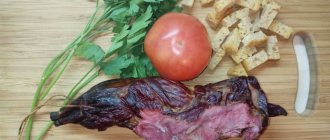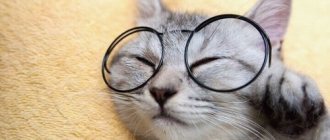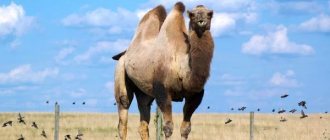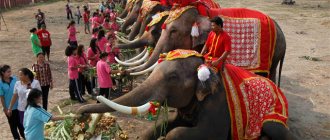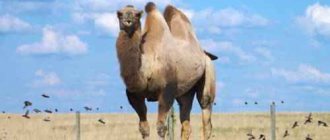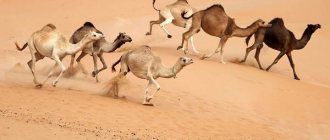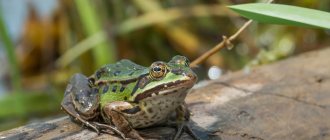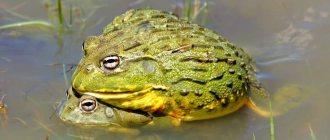Frogs: description
The frog family is distinguished by the fact that they do not have a clearly defined neck, so it seems that the head is literally one piece with a wide body. These animals also lack a tail, which is reflected in the very name of the order and is its characteristic difference. Frogs have simply unique vision, and they can control their living space within 360 degrees.
Appearance
Frogs have a relatively large head, flat in shape, along the edges of which there are bulging eyes. These animals, in comparison with some other representatives of the order, have 2 pairs of eyelids - lower and upper. Hidden under the lower eyelid is the nictitating membrane, which is also called the “third eyelid.” In the back of the eyes there is the so-called eardrum, which consists of an area covered with thin skin. Above the relatively large mouth you can see two nostrils armed with special valves. The frog's mouth is armed with fairly small teeth.
The frog's front legs are armed with four very short fingers, compared to the hind legs, which are much better developed and end with five fingers, between which there is a special membrane of skin, which allows the frog to feel great in the water element. Frogs' toes do not have claws, which is also considered a characteristic feature of the family. At the back of the body is the so-called cloaca, which is the only outlet for processed food components. The frog's body is covered with bare skin, covered with a layer of special mucus, which is secreted by a large number of subcutaneous glands of the frog.
Interesting moment! The European frog does not grow more than 10 centimeters in length, while the African goliath frog is considered the largest representative of the family, growing up to half a meter in length and gaining weight of several kilograms.
As a rule, the size of frogs depends on their species, although generally their size ranges from 0.8 to 32 centimeters. The color of frogs is also so diverse, which are often distinguished by the rather variegated coloring of their bodies. Often the body color of these animals is associated with their natural habitat conditions, which allows them to easily camouflage among various vegetation, grasses, etc.
Often, the bright color of an animal is evidence of their toxicity, while toxic substances are produced by special glands located on the animal’s skin. These substances can be very dangerous not only for animals, but also for humans. Some species are able to imitate the “war” colors of poisonous frogs to protect themselves from natural enemies.
Behavior and lifestyle
Frogs can safely be considered a unique family, since they move without problems on land, make large jumps, easily climb trees, dig underground holes, and also swim, run, walk, and even glide from a height, depending on the species.
Another peculiarity of frogs is that they are able to absorb oxygen through their skin. This allows the animal to feel great both in water and on land. At the same time, there are varieties that go to reservoirs exclusively during breeding periods.
Interesting to know! Animals show their activity depending on the variety. Some species prefer to hunt exclusively in the dark, while others are active throughout 24 hours.
An interesting fact is that the lungs of frogs serve mainly to make sounds similar to croaking. The presence of sound bubbles and resonators allows the animal to generate a wide range of sounds. This is especially true during breeding periods, since animals have to attract the opposite sex.
Adult frogs, from time to time, shed their skin and immediately eat it, after which they wait until the new skin has all the necessary functions. Almost all representatives of this family prefer to lead a sedentary lifestyle, while they are capable of migrating short distances during the mating season. Frogs living in temperate latitudes fall into torpor in winter.
FROGS - INTERESTING FACTS
How long do frogs live
These unique animals, depending on their species, live for different periods of time. Scientists determine this factor using the method of skeletochronology. This method makes it possible to determine both growth rates of development and periods of onset of puberty.
It is important to know! Scientists believe that most species of frogs can live in natural conditions for about 10 years. At the same time, based on many years of observations, it was possible to establish that for some species and subspecies a life cycle lasting 30 years is not a problem.
Sexual dimorphism
For many amphibians, both permanent and seasonal sexual dimorphism is considered characteristic, and frogs are no exception. Some tree frogs have enlarged pads on their toes, which allows males to actively attract females by tapping them on the ground. In some male species, the eardrums are significantly enlarged. The so-called gonadotropic hormones, which appear in the body of animals depending on the season, are characteristic of seasonal dimorphism.
Important point! It is often not possible to determine gender visually, based on just one sign. In this case, it is necessary to navigate several distinctive factors at once.
For male frogs, a characteristic feature that allows them to be distinguished from females is the fact that, under the influence of hormones, their nuptial pads begin to form. Mating pads appear on the bottom of the front paws, on the toes, and also around the mouth, which allows the male and female to reliably remain in the mated state, regardless of the nature of external influences.
Interesting facts about the animal
- The presence of resonators and bubbles allows the individual to vocalize in the form of various sounds. Croaking is especially common during the breeding season.
- Amphibians can migrate short distances. Basically they lead a sedentary lifestyle.
- Pond Frogs have small teeth on the upper jaw. They swallow food whole, catching it with the help of a long tongue covered with sticky mucus. If an insect flies by, within a second it sticks to it.
- Sometimes amphibians form small aggregations, and each individual has its own area up to 1 square meter in size. If the territory is violated by a relative, then a showdown will begin. Adults will use loud screams and jumps towards the intruder.
- Sharp-faced frogs and grass frogs often live in the vicinity of Prudovaya.
- The creatures tolerate heat well. Their skin actively evaporates moisture, preventing overheating.
- Using amphibians, I create new medicines.
- The animal has excellent eyesight. She can look straight ahead, up and to the side. She may not close her eyes while sleeping.
- The stages of development of an amphibian in the natural environment and in an aquarium are the same.
- In some Western European countries, the meat of this animal is eaten.
Types of frogs
To date, experts have identified more than 550 species of animals representing the frog family. It should be noted that this family includes several subfamilies, represented by African forest frogs, disk-toed frogs and toad frogs, dwarf frogs and true frogs, including corymb-toed frogs.
Some species are very popular among those who like to keep rare animals at home, and therefore are kept as exotic pets.
The most interesting species of frogs include:
- Dominican tree frog.
- Australian tree frog.
- Some tree and poison frogs.
- Smooth clawed frog (aibolite frog).
- Red-eyed tree frog.
- Lake frog.
- Pointy-faced frog.
- Garlic frog.
The transparent or glass frog, the cocoy poison frog, the hairy and flying frog, the bullfrog, the clown frog, and the sharp-nosed tree frog are considered the most unusual species.
Important point! The shape of the body also depends on the type of frog, as evidenced by data from frogs such as the copepod, in which the body shape is flat, as if crushed, while in piglet frogs it is, on the contrary, voluminous, as if bloated.
The most unusual frogs and toads. top 10
Habitat
The habitat of the family is represented quite widely, so frogs can be found without problems on almost all continents, regardless of the climate zone. At the same time, most species prefer to inhabit the tropics, giving preference to fresh water bodies.
The True Frog family is widespread in the natural environment, although they cannot be found within South America, southern Australia, or New Zealand. On the territory of our country, the grass frog and the pond frog are mainly found.
The habitat of some species is associated with certain natural factors that limit the distribution of the species. Such factors include the presence of large rivers, the presence of mountain ranges or deserts, etc. This should also include barriers of artificial origin, in the form of canals, highways, etc.
In tropical conditions, all conditions are created for a greater diversity of species, compared to conditions in temperate and cold latitudes. And, nevertheless, some varieties are found even in polar conditions, as well as in bodies of salt water.
What do frogs eat
Frogs are considered predatory animals because they feed on animal food, represented by various insects. These amphibians eat large quantities of annoying insects such as mosquitoes. In addition, their diet includes various types of butterflies and small invertebrates. Sufficiently large subspecies can eat fairly large objects of animal origin, including their small relatives.
It is important to note! Most species of frogs are characterized by the fact that they bring great benefits to people, since they destroy large quantities of various insects, including harmful ones.
Frogs hunt by actively using their long and sticky tongue, and they have no problem catching insects in flight. Among the huge variety of species, there are omnivorous representatives of the family, which, along with animal food, consume berries and fruits.
Reproduction and offspring
Animals that live in tropical conditions reproduce during the rainy season, while those species that live in temperate latitudes reproduce with the arrival of spring, after emerging from hibernation. Before the breeding season, animals form numerous groups, with males preferring to occupy all the hills. This is necessary so that females can hear them at a considerable distance.
Males climb onto the backs of females and fertilize the eggs that the females lay. In this case, the caviar is bunched into dense formations, round in shape. Some species living in South Africa secrete a copious, foaming liquid that envelops all the eggs, forming a kind of nest. After some time, the foaming secretion hardens, after which the process of incubation of eggs occurs, followed by the appearance of offspring.
The number of eggs depends on the species and can range from several dozen pieces to several tens of thousands of pieces. Incubation periods depend on natural conditions and can range from 3 to 10 days. After birth, the offspring begin to develop rapidly, turning first into tadpoles and then into small frogs. This period can last from 40 to 120 days, depending on the variety.
Interesting to know! Most species are characterized by the absence of related feelings, so small frogs can always become prey for larger relatives. An exception may be bullfrogs, which protect their offspring from natural enemies.
Natural enemies
Frogs, especially young ones, have a sufficient number of natural enemies. They can be leeches, the faces of swimming beetles and dragonflies, etc. As for adult individuals, they can be hunted by predatory fish species, birds of prey, as well as reptiles such as snakes and vipers. Frogs are also included in the diet of waterfowl, as well as some predatory animals, such as water rats, muskrats, representatives of mustelids, etc.
Pond Frog in the Red Book
The Pond Frog has been assigned the status of a conditionally rare species. The amphibian is included in the list of specimens that are recommended to be included in the Red Book of the Samara Region. Thus, the amphibian is at risk.
Main causes of extinction
This species has become endangered for the following reasons:
- drainage reclamation;
- pollution of rivers and lakes;
- small number of suitable habitats.
All frogs are very sensitive to the environment where they live. They need wetlands, streams, and ponds to survive. However, drainage of water bodies and construction of roads cause global damage to all species.
The species is listed in the Red Book of the Lipetsk Region and is on the monitoring list.
A fungus that grows on the skin and causes heart failure is dangerous for amphibians. Harmful bacteria can destroy an entire population.
Current population situation
The number of individuals of the species is low. The population is usually about 40-60. Population trends have not been determined. Experts from different countries breed individuals in zoos and laboratories to increase their numbers, and then release them into their natural habitat.
However, maintaining and increasing the number of copies is not so easy. This requires certain costs and the presence of an optimal atmosphere for breeding.
Are protective measures required?
Measures to protect Pond Frogs are simply necessary in the modern world. People cannot live without them for the following reasons:
- Science will slow down, because amphibians are indispensable in scientific experiments.
- Reservoirs will become more dangerous, as tadpoles eat a lot of algae.
- The food chain will collapse.
- There will be more insects, including malaria mosquitoes, which are dangerous to humans.
- The greenhouse effect will increase.
Thus, it is important to preserve Pond Frogs, which are essential for the health of people and the entire planet.
Population and species status
According to scientists, an irreversible process is currently underway to reduce the total number of this family. In this regard, almost a quarter of all species are on the verge of complete extinction. The main factors that significantly influence the populations of this family include significant changes in climatic conditions on a global scale, the presence of alien predators that are not typical for the family, as well as human activity associated with the destruction of the usual habitat.
Serious factors include infectious diseases such as chytridiomycosis and ranavirus, which cause serious damage to the population of the frog family. It should also be noted that these frogs, like amphibians in general, are quite sensitive to components that pollute the environment. This is due both to the structural features of their body and to the features of their life cycle.
Distribution and abundance
In Russia, it is distributed in the central regions of the European part and the Middle Volga region to the Republic of Bashkortostan in the east. The northern border of the species’ range runs through the southern regions of the Leningrad, Vologda and Kirov regions, the southern border - through the Belgorod, Voronezh, Tambov, Penza and Samara regions [2-5]. In the Tula region, it was observed mainly in the coniferous-deciduous and broad-leaved forests of the Dubensky, Zaoksky, Leninsky, Odoevsky, Suvorovsky and Yasnogorsky districts, as well as within the administrative borders of the city of Tula [6-9]. In 2006, it was found in the forest-steppe part of the region (fish breeding pond of the Lyutorichesky fish farm, Kimovsky district) [10]. A total of 11 locations were identified. The number of individuals in most populations is low – as a rule, no more than 40-60 individuals [6]. Rare species, population trends unknown.
Differences between frogs and toads
For those who don’t know, there is no difference between a frog and a toad, although in fact they are completely different animals, despite the fact that both the toad and the frog are amphibians that feel great both on land and in water. In this case, one should also take into account the fact that they have a clear external similarity.
A toad differs from a frog in that it has rough skin, its legs are much shorter, and its appearance is not as attractive as that of a frog. If the frog is able to make long jumps, then the toad will not be able to do this due to its short legs.
WHAT is the difference between a FROG and a TOAD, you definitely didn’t know this about a toad
Frog with a bright green stripe - who is she?
Lake frog
If you have been fishing, then you have probably noticed a large concentration of frogs near the shore of a lake or pond. Often, a frog called a “lake frog” lives in such places. It is considered the largest representative of the frog family in our country. The lake frog belongs to the class Amphibians, order – Tailless.
Reproduction and lifespan
Frogs reproduce by laying eggs in water, and the quantity is truly enormous and amazing, sometimes reaching up to 20 thousand eggs at a time. Grass and pond frogs lay up to hundreds of eggs, which are large lumps. Sometimes females do this in groups.
The eggs hatch into tadpoles. These creatures are frog larvae, breathe through gills, can exist and move only in an aquatic environment, and have a tail. The transformation of eggs into tadpoles takes from 7 to 10 days.
Over time, the tadpoles begin to change greatly and go through a stage of metamorphosis, which lasts about 4 months. First, their hind limbs grow, then their forelimbs, then the tail-rudder disappears, and the tadpoles turn into adults with the distinctive features of their type of frogs, ready for life on earth. At three years old, frogs become sexually mature.
The photo shows frog eggs
Measuring the lifespan of frogs is quite difficult. But according to scientific research, using measurements of the growth of the phalanges of the fingers by season, data were obtained that allowed us to believe that adult individuals are able to live up to 10 years, and taking into account the tadpole stage, up to 14 years.
What do frog tadpoles eat?
The larval stage of different species of frogs is very similar.
Tadpoles hatched from eggs do not have a mouth opening. The embryonic supply of nutrients ends after about seven days, when their length reaches 1.5 cm. During this period, the mouth breaks through and independent feeding begins.
The main food of tadpoles is single-celled algae. Random impurities that are absorbed by the frog’s body along with the main food are mold fungi, protozoan flagellates and other microorganisms.
The tadpole's mouthparts are well adapted for scraping off algae deposits and are shaped like a “beak” surrounded by fringed lips. The lower one has rough growths and is larger in size than the upper one. Tadpoles feed during the day, being in warm water in the shallows and off the coast, forming mass aggregations (up to 10,000 pieces). Not all of them survive, since the larvae of frogs serve as food for birds, fish and many other inhabitants of the reservoir.
The tadpoles turn into young frogs. They are quite gluttonous. When full, their stomach volume exceeds 1/5 of the total mass.
Another curious detail is that if there is not enough animal food in the reservoir, the tadpole overwinters in the larval stage, postponing its transformation into a predator until spring.
How to recognize a lake frog?
The lake frog has a unique coloring - a stripe on its back on a greenish skin tone.
These amphibians grow up to 15 centimeters in length, and their weight can reach 200 grams. As for skin color, it is very diverse, although the predominant shade is green-brown with dark spots. Some individuals have a bright green stripe along the entire back.
Natural enemies of the lake frog - who are they?
In this case, the frog is an excellent lunch for the heron.
Perhaps this inhabitant of lakes and ponds can be considered very popular as food for other animals. Both aquatic inhabitants (pike, perch and other fish), and land dwellers (snakes, vipers, rats, badgers, minks, ferrets, weasels, foxes, wolves, otters), and even winged predators (seagulls, ducks, storks, graces, herons, crows and others).
